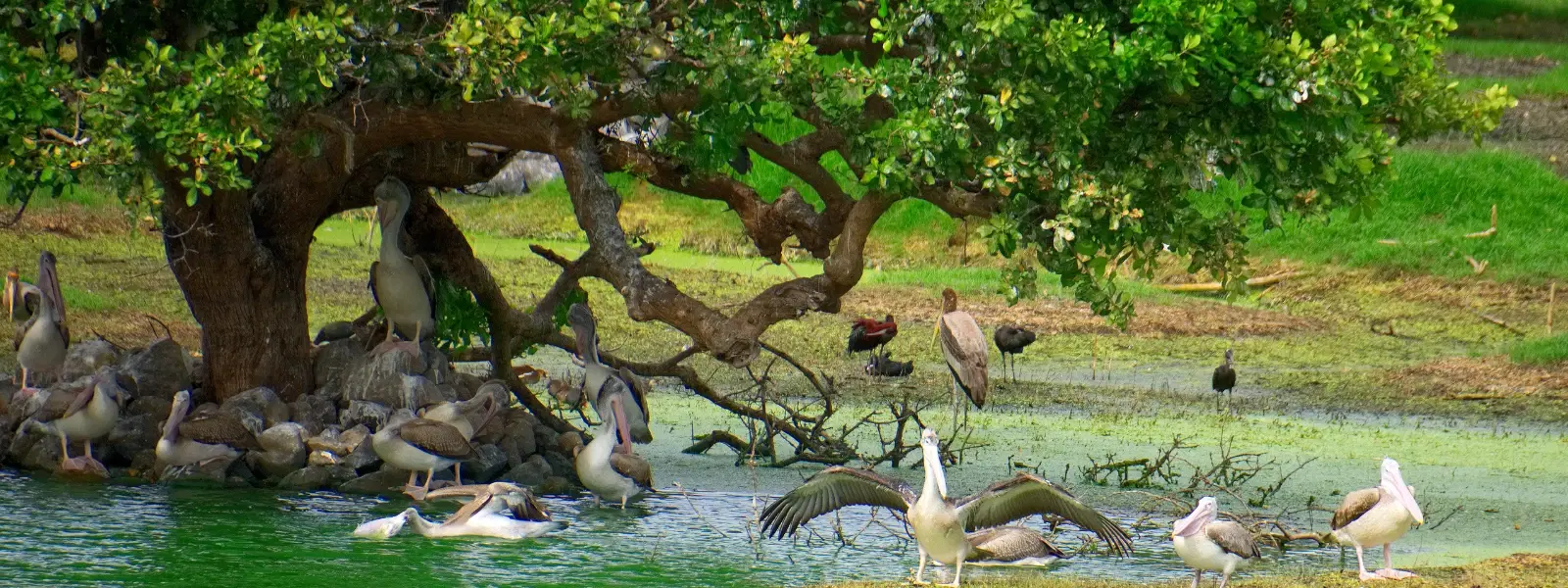
Hotels
•03 min read

India is a treasure trove of biodiversity, offering some of the most mesmerizing natural spectacles for bird watchers and wildlife enthusiasts. The country’s bird sanctuaries, particularly the largest bird sanctuary in India, are not only havens for diverse bird species but also hubs of conservation and eco-tourism. In this blog post, you will discover key insights about these avian reserves, learn practical tips for an enriching visit, and get answers to frequently asked questions that illuminate the significance of these natural gems.
A bird sanctuary is a protected area dedicated to the conservation of native and migratory bird species along with their natural habitats. These areas function as safe havens where birds can breed, feed, and shelter without the pressures of urban development or poaching. By providing controlled environments, bird sanctuaries aid in scientific research and offer bird enthusiasts the chance to experience nature up close.
India's bird sanctuaries play a crucial role in preserving endangered species and offering safe passageways for migratory birds. They serve as living classrooms for educating locals and tourists about biodiversity and environmental stewardship. Moreover, the sanctuaries promote eco-tourism, drawing nature lovers who contribute to local economies and help spread awareness about conservation efforts.
The largest bird sanctuary in India is the renowned Keoladeo National Park in Bharatpur, Rajasthan. Established decades ago, this sanctuary is steeped in history and boasts a unique blend of wetlands, woodlands, and grasslands. Its expansive network of water bodies and rich vegetation provide the perfect backdrop for a wide variety of bird species, ranging from resident birds to spectacular migratory visitors.
Visitors to this sprawling avian reserve are treated to a vibrant palette of bird species, including rare migratory birds that grace the skies during distinct seasons. Bird watching is the most popular activity here, with enthusiasts armed with binoculars and cameras eager to capture fleeting glimpses of colorful plumages. Photography, guided tours, and nature walks further enhance the experience, letting you explore both the scenic beauty and the storied legacy of this protected habitat.

Did You Know?
Did you know the Keoladeo National Park is a UNESCO World Heritage Site and hosts over 370 bird species annually, including Siberian cranes during migration season?
Beyond Bharatpur, India is dotted with numerous bird sanctuaries that continue to inspire awe in naturalists. For instance, the Vedanthangal Bird Sanctuary in Tamil Nadu offers an intimate look at local bird life, while the Chilika Lake Bird Sanctuary in Odisha is a premier spot to witness vibrant migratory patterns. Similarly, the Ranganathittu Bird Sanctuary in Karnataka is celebrated for its breathtaking arrays of water birds, making it one of the top bird watching places in India.
Each state in India contributes uniquely to the tapestry of bird conservation. Regions like West Bengal, Maharashtra, and Kerala have sanctuaries that not only serve as bird conservation areas but also act as cultural landmarks. These protected bird habitats in India are vital for sustaining local ecosystems and informing global conservation strategies, making them indispensable for wildlife tourism in India.
Bird sanctuaries in India are at the forefront of conservation initiatives. Organizations such as the Indian Bird Conservation Network (IBCN) work closely with sanctuaries to ensure the survival of endangered species. Many of these sanctuaries are also designated Ramsar sites, highlighting their international importance as wetlands. Through proactive measures such as habitat restoration and public education, these efforts help protect migratory birds and maintain biodiversity.
Wildlife tourism in India benefits immensely from the rich experiences provided by its sanctuaries. By attracting bird lovers, nature enthusiasts, and photographers alike, these sites support local communities economically. Eco-tourism initiatives here emphasize sustainable travel practices which, in turn, foster a deeper connection between visitors and the natural world. The benefits of this tourism are felt not just in financial gains but also in the enhanced community engagement in conservation efforts.

The Keoladeo National Park in Bharatpur, Rajasthan, is recognized as the largest bird sanctuary in India.
India has over 70 bird sanctuaries spread across various states, each playing a vital role in conservation.
The Bharatpur Bird Sanctuary, better known as Keoladeo National Park, is one of the most famous bird sanctuaries in India, celebrated for its migratory birds.
Popular sanctuaries include Chilika Lake Bird Sanctuary, Nal Sarovar Bird Sanctuary, and Ranganathittu Bird Sanctuary, all renowned for hosting vibrant migratory bird populations.
They provide protected habitats for endangered and migratory birds, promote biodiversity, and play an integral role in educating the public about wildlife conservation.
The largest bird sanctuary in India, embodied by the Keoladeo National Park, stands as a beacon of conservation and ecological beauty. This exploration of bird sanctuaries in India reveals a tapestry of natural history, community engagement, and environmental stewardship that makes these sanctuaries crucial for both wildlife and eco-tourism. Whether you are a curious wanderer, a meticulous planner, a professional on the move, or a luxury seeker with an eye for nature’s grandeur, these protected bird habitats offer unforgettable experiences that beckon you to explore and protect our natural heritage.